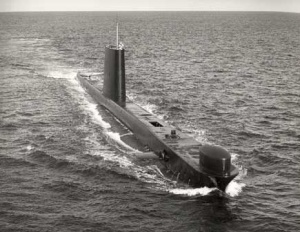HMAS Ovens was the third of six Oberon class, diesel electric patrol submarines built for the Royal Australian Navy (RAN) at an initial cost of $9 million each. The Oberon class, or ‘O-boats’, as they became known, were built by the Scott Shipbuilding and Engineering Company in Greenock, Scotland. Designed for quiet running, the Oberons were both antisurface and antisubmarine warfare vessels, capable of 30-day patrol cycles. To remain submerged for lengthy periods a ‘snort’ (snorkel) system was incorporated into their design to allow batteries to be recharged and to expel stale air.

HMAS Ovens was launched at Greenock on 4 December 1967 by the Viscountess Slim (the wife of the son of Field Marshal Viscount Slim) and was commissioned on 18 April 1969. Sea-acceptance and weapons trials commenced in May and on completion of these Ovens began its voyage to Australia, arriving in Sydney on 17 October 1969.
In April 1970, Ovens was one of an international fleet of 45 vessels that assembled in Sydney to commemorate the 200th anniversary of Captain James Cook’s landing on the east coast of Australia. Participation in a number of multinational exercises followed. The exercises helped forge closer links with Thailand, New Zealand and Singapore. From January to June 1972 Ovens was the first RAN submarine to join the Australia-New Zealand-United Kingdom (ANZUK) force based in Singapore.
In September 1973, Ovens was decommissioned and given a two-year-long, major refit at Cockatoo Island Dockyard, Sydney. Oberon class submarine refits were complex in nature and involved removing the boat's 480-cell battery, accommodation fittings and all electrical and mechanical machinery with the exception of the main motors. Normally the submarine was placed on a slave dock (a submersible platform that, when re-floated with a vessel aboard, became a floating dry dock) which enabled the hull to be examined for corrosion and hull-preservation work to be done. During that refit, Ovens became the first of the RAN’s submarines to be fitted with a new, long-range, passive sonar system. Recommissioned on 31 October 1975, Ovens undertook a period of post-refit trials before taking part in exercises off Australia’s east coast. It deployed to Southeast Asia in May 1976.
Over the next four years, Ovens operated around the Australian coast and the Pacific, and participated in numerous regional exercises including the two-yearly, multinational Rim of the Pacific (RIMPAC) exercise. On 10 March 1980, Ovens ended its second commission. It entered Cockatoo Island Dockyard for a major refit and an update of its weapons and sensors. Industrial disputes in the dockyard resulted in the refit taking nearly two and a half years.
Following re-commissioning, a period of post-refit trials involving HMAS Hobart and HMNZS Otago, Ovens conducted sea-acceptance trials. During Oven’s third commission it regularly deployed to the Pacific and Hawaii, where it was a participant in RIMPAC exercises. Ovens was awarded its Mk 48 torpedo weapons certification in 1982 and in November 1985 it conducted the first of the RAN’s subsurface firings of the Harpoon antiship missile. Ovens scored a direct hit on a distant, small, remotely controlled surface target in the US Navy’s Pacific Missile Range Facility near Hawaii.
After participating in RIMPAC 86, Ovens operated in Australian waters, making numerous visits to local ports and participating in a broad range of exercises. In March 1987, it conducted a successful Mk 48 torpedo war-shot, firing against the stripped down hull of the former HMAS Colac. After a brief deployment to Western Australia and a visit to New Zealand, Ovens returned to Sydney for its third and final major refit, at Cockatoo Island Dockyard again, and taking approximately two and a half years again. Ovens’ communications centre was rebuilt, its pressure hull repaired and work was done on some of the main ballast tanks.
Post-refit trials followed before Ovens re-joined the fleet, where it participated in exercises off the Australian coast. In early 1991, Ovens deployed for exercises with the United States Navy and the Japanese Maritime Self Defence Force in Asian waters. In the latter part of the year, Ovens, with other Sydney-based units of the RAN, took part in exercises off the east coast of Australia. 1992 saw Ovens given a safety assessment by the Submarine Sea Training Group, participate in RAN Exercise Kangaroo 92 off Darwin, and join Exercise Starfish 92 in Southeast Asia.
In 1993 Ovens was awarded the Submarine Fighting Efficiency Shield and, for the third time, won the Mk 48 Firing Proficiency Shield. It was involved in local exercises and spent a brief period at Cockatoo Island Dockyard for a mid-cycle survey. Work-ups and an operational readiness evaluation preceded passage to Southeast Asia for Exercise Starfish 93. After visits to Singapore and Bali, Ovens returned to Sydney in October.
Ovens was involved in exercises off the east coast of Australia before it deployed to Hawaii for RIMPAC 94. Goodwill visits in the south Pacific were undertaken during its return voyage to Australia and, in August, it underwent a short period of maintenance in Sydney before undertaking trials off the New South Wales coast. A brief deployment to Western Australian waters followed.

HMAS Ovens being towed away from HMAS Stirling after decommissioning.
Ovens' final year in commission began with routine exercises off the New South Wales coast followed by a brief visit to Newcastle and a deployment to New Zealand where it operated with ships of the Royal New Zealand Navy and France’s Marine Nationale.
On Friday 4 August 1995, Ovens departed HMAS Platypus, Sydney, for the last time to decommission in Western Australia. During the voyage to Western Australia it called at Mackay, Townsville, Darwin and Fremantle before arriving at HMAS Stirling on Monday 28 August. While in Fremantle, Ovens was opened to the public. Public access would continue when the submarine was spared from the breakers yard and became a museum piece in Fremantle. HMAS Ovens decommissioned on 1 December 1995 at HMAS Stirling. During its 26-year life, it travelled in excess of 410 000 nautical miles.



